CNC Shelter
Jump to navigation
Jump to search
Main > Housing and construction
Shelter 2.0 is an open source design for personal housing built from wood parts cut with a CNC machine.
Specifications and CAD files
The Shelter 2.0 (SK130 model) is a 10'x13' hut. It has a raised floor, lockable doors for security, open space in walls for insulation, and is built from materials that give it a lifespan much longer than other options. It was also designed to be constructed by unskilled labor with minimal tools, and the pieces sized to efficiently fit in a shipping container.
- CAD File: http://www.shelter20.com/wp-content/Shelter20%20content/Files/SK130.zip
- Instructions: https://docs.google.com/document/d/1xO8oIIbTrh-GvJaSLZXaE4TsoOwbRyJDKsEPzhzuK-E/edit?hl=en&authkey=CPfugKEF
- Sketchup and info: http://www.shelter20.com/cnc-files-and-instructions/
Evaluation
Estimated Material Cost: $1000
Estimated Construction time: 20 man-hours
Advantages
- Can put them side by side with a gutter between then and still not loose light or ventilation.
- The system is also well resolved and will likely result in less mess and hold ups on site.
- Being rectangular, they will be efficient at fitting people in to sleep - more so than the round yurts.
Additional Considerations
(thanks to Alex Whitcroft)
- Raise them off the ground to stop them rotting.
- Get the windows to open.
- Insulation should NOT be put directly against the metal roofing as this can get hot enough to ignite the insulation. A 2 inch air gap should be allowed. This air gap should be vented to allow it to cool and not mould. "House wrap"/"Tyvek" can be used to retail the insulation and stop it touching the metal. I would suggest 8-12 inches of natural insulation like cellulose - you could halve this thickness if you used synthetic/polymer foam insulation.
- Should also find a way to protect all of the wood boards from the elements as they won't last long otherwise. Large roof overhangs or hardier wooden or metal cladding are both options.
- If you are going to put them next to each other, ideally you would put gutters between them rather than having all the water draining to the ground between them. the metal roofing would want to be adapted to create a drip line at maybe waste level where shared gutter could be fitted between each hut. May sure that this gutter is oversized to prevent any water overflowing the sides in heavy rain and also, ideally, make sure that if any water did overflow it would not damage the structure.
- Possible Modification: increase the height to make bunk beds possible on each side. This may result in the curve of the roof starting higher up and having a shallow/flatter curve on top. This should be fine.
- Make sure also that all the water that lands on the roof can drain. As the corrugations run length-ways the top-most dips may well hold some water. This will eventually cause the metal to corrode through, even if you use galvanized steel. If you are going to use corrugated metal then you should provide a way for the water to drain off at one of the ends (not over the door).
- You shouldn't need to use corrugated metal. Thin flat sheet should also work, although will move more and therefore may be more noisy.
- If they could be located with any sun-exposed glazing facing south, that would be good. Given the small windows this is not essential and if the main social structure (which I'm assuming is adjacent) faces south if it plans to be walled in at some stage then that would be worth more.
- I would suggest designing the spans/post spacings of the larger roof structure to be a nice round number of "hut modules" if they are to be interconnected, etc at some stage. Eg: 3 huts fits between each pair of posts. This will mean you only have one set of measurement to work out and the overall look of the structure will be better.
- You may find it easier to build one larger roof over all the huts too and then you only need to build walls and floor for the huts.

